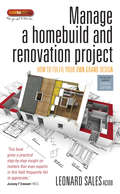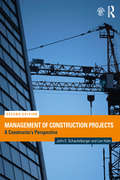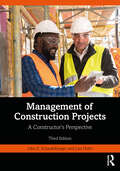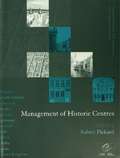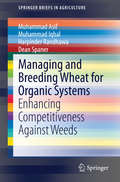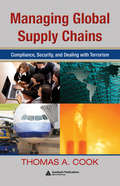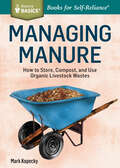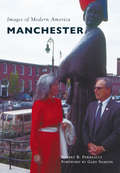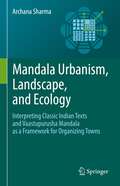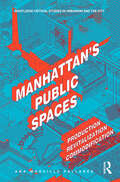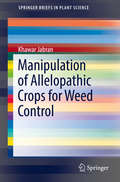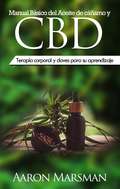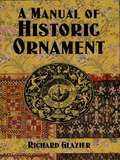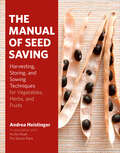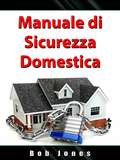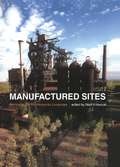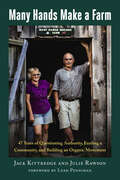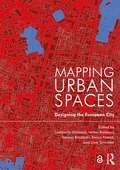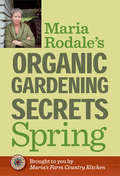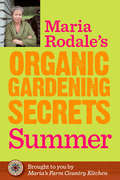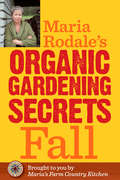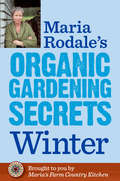- Table View
- List View
Manage A Home Build And Renovation Project 4th Edition: How To Fulfil Your Own Grand Design
by Leonard SalesUndertaking a building or renovation project can be a bit daunting. But with the help of this book you will be in control at all times, confident in your decision making, and sure of getting the job done on time and to a high standard. It includes proven and simple-to-use management techniques that would suit projects ranging from one thousand to one million pounds.Contents: Introduction; About the author; 1. Getting started; 2. Know your requirements; 3. Contacting contractors; 4. Establishing credibility; 5. Obtaining and agreeing quotes; 6. Starting the work; 7. Financial arrangements; 8. Operation and maintenance manuals; 9. Good working relations; 10. Record-keeping; 11. Professional and site teams; Index
Manage A Home Build And Renovation Project 4th Edition: How to fulfil your own grand design
by Leonard SalesUndertaking a building or renovation project can be a bit daunting. But with the help of this book you will be in control at all times, confident in your decision making, and sure of getting the job done on time and to a high standard. It includes proven and simple-to-use management techniques that would suit projects ranging from one thousand to one million pounds.Contents: Introduction; About the author; 1. Getting started; 2. Know your requirements; 3. Contacting contractors; 4. Establishing credibility; 5. Obtaining and agreeing quotes; 6. Starting the work; 7. Financial arrangements; 8. Operation and maintenance manuals; 9. Good working relations; 10. Record-keeping; 11. Professional and site teams; Index
Management of Construction Projects: A Constructor's Perspective
by John E. Schaufelberger Len HolmUnlike the majority of construction project management textbooks out there, Management of Construction Projects takes a distinctive approach by setting itself in the context of a single and real-world construction project throughout and also by looking at construction project management from the constructor’s perspective. This project-based learning approach emphasizes the skills, knowledge, and techniques students require to become successful project managers. This second edition uses a brand new, larger, and more challenging case study to take students through key stages of the process, including: contracts and subcontracting; estimating, scheduling, and planning; supply chain and materials management; cost control, quality, and safety; project leadership and ethics; and claims, disputes, and project close-outs. Also new to this edition is coverage of emergent industry trends such as LEAN, LEED, and BIM. The book contains essential features such as review questions, exercises, and chapter summaries, while example plans, schedules, contracts, and other documents are stored on a companion website. Written in straightforward language from a constructor’s perspective, this textbook gives a realistic overview and review of the roles of project managers and everything they need to know in order to see a successful project through from start to finish.
Management of Construction Projects: A Constructor's Perspective
by John Schaufelberger Len HolmUnique among construction project management textbooks, Management of Construction Projects, third edition, takes the constructor’s perspective, carefully analyzing a complex, real-world construction case study from multiple angles to demonstrate the skills, knowledge, and techniques students require to become successful project managers. Popular as an undergraduate text and as a contractor resource, the book identifies key stages of the project-management process, such as delivery methods and contracts; estimating, planning, and scheduling; preconstruction services; subcontracting and material management; documentation, communications, and payment; controls, quality, and safety; leadership and ethics; and claims, disputes, and close-out.This third edition includes a novel case study, a new chapter on preconstruction services, updated contract forms and figures, and additional student exercises, and integrates use of project management technology. Topics include building information models, sustainable construction, environmental compliance, lean construction, and off-site construction. Boxed examples, or short case studies, have been included with each chapter. These examples correspond directly to the chapters in which they are included and give the reader an applied approach to learning the concepts presented.While primarily focused on the management of commercial projects, the principles and techniques in Management of Construction Projects also apply to residential, industrial, and heavy construction. Written in straightforward language from a constructor’s perspective, this textbook prepares upcoming construction project managers with everything they need to see a successful project through from start to finish.
Management of Historic Centres (Conservation Of The European Built Heritage Ser.)
by Robert PickardThis book examines key themes for the management of historic urban centres within a representative sample of centres in different European countries. The twelve historic centres that have been chosen are spread throughout Europe. They are diverse in character and the range includes small towns, cities and urban centres within cities. Some have been designated by UNESCO as World Heritage Sites or Cities, whilst others have recognition, or have been proposed as European Cities of Culture. The centres have all faced different problems and a variety of approaches have been utilised which are also examined. For each of the historic centres in the book the authors broadly cover a number of common themes: the policy and planning framework; management and regeneration action; environmental management; tourism and heritage management; and sustainability.
Managing and Breeding Wheat for Organic Systems
by Muhammad Asif Muhammad Iqbal Harpinder Randhawa Dean SpanerGenetically uniform cultivars in many self-pollinated cereal crops dominate commercial production in high-input environments especially due to their high grain yields and wide geographical adaptation. These cultivars generally perform well under favorable and high-input farming systems but their optimal performance cannot be achieved on marginal/organic lands or without the use of external chemical inputs (fertilizers, herbicides and pesticides). Cereal breeding programs aim at evaluating candidate lines/cultivars for agronomic, disease and quality traits in a weed free environment that makes it impossible to identify traits conferring competitive ability against weeds. Moreover, quantification of competitive ability is a complex phenomenon which is affected by range of growth traits. Above (e. g. light) and below (e. g. water and nutrients) ground resources also influence competitiveness to a greater extent. Competitiveness is quantitatively inherited trait which is heavily influenced by many factors including genotype, management, environment and their interaction. Sound plant breeding techniques and good experimental designs are prerequisites for maximizing genetic gains to breed cultivars for organically managed lands. The brief is focused on breeding wheat for enhanced competitive ability along with other agronomic, genetic and molecular studies that have been undertaken to improve weed suppression, disease resistance and quality in organically managed lands. The examples from other cereals have also been highlighted to compare wheat with other cereal crops.
Managing Global Supply Chains: Compliance, Security, and Dealing with Terrorism
by Thomas A. CookSeptember 11, 2001 had a profound impact upon individuals, institutions, and governments, but also upon the world of global trade. Years later, the reverberations of this deliberate and focused act of terrorism are manifest in much more stringent logistics, documentary requirements, and regulations. A single source on compliance and security, writt
Managing Manure: How to Store, Compost, and Use Organic Livestock Wastes. A Storey BASICS®Title (Storey Basics)
by Mark KopeckyAnyone who raises livestock or keeps horses must deal with manure. This Storey BASICS® guide shows you how to make this process manageable, useful, and even profitable. Organic dairy farmer and soil scientist Mark Kopecky explains the fundamentals of storing, composting, and spreading manure; the nutritional content of manure from various animals; and how to handle, transport, and market manure for additional income. You’ll soon discover that your farm’s waste may be its biggest asset.
Manchester: Vivre La Difference (Images of Modern America)
by Gary Samson Robert B. PerreaultKnown as New Hampshire�s �Queen City,� Manchester could be called �Change City.� Throughout its history, it has reinvented itself many times. From a Native American fishing and gathering place called Amoskeag to a Yankee colonial town known as Derryfield, it became a multiethnic industrial center, the �Manchester of America,� home of the world-famous Amoskeag Manufacturing Company (1831�1936). When Amoskeag Manufacturing closed during the Depression, �the city that would not die� was reborn through more diversified industries that carried it through the post�World War II era. Several decades of urban renewal saw the demolition of many older buildings and entire neighborhoods. Lamenting the loss of Boston & Maine Railroad�s Union Station and St. Mary�s Bank�s marble building, Manchester residents drew inspiration from the US bicentennial in 1976 to create a renaissance of interest in history and architecture, which brought about the adaptation to modern use of several remaining older structures. Yet more major losses came in 1978 and 1989 with the destruction of the State Theatre and Manchester�s beloved Notre Dame Bridge.
Mandala Urbanism, Landscape, and Ecology: Interpreting classic Indian texts and Vaastupurusha mandala as a framework for organizing towns
by Archana SharmaClassic Indian texts and Vaastupurusha Mandala are not often discussed in the western discourse on urbanism, even while much of these predate the commonly taught European writings. This book sheds light on some of those forgotten concepts, thus making the lesser discussed classic Indian town organization ideas accessible to architecture, landscape, and urban planning students worldwide. The resonance of these concepts in present times are reviewed through case studies of select Hindu temple towns in India. Furthermore, the author underscores the formal abstraction of the classic Indian Mandala and transplants the discourse from sociology to socio-ecologically adept trans-disciplinary design thinking. The creative interpretations offer a premise to start revising classic models for current practice to influence the urbanism and ecology of a place in accordance with the changing climate.
Manhattan Classic
by Geoffrey LynchThe Dakota. The Apthorp. The San Remo. The names of these legendary New York apartment buildings evoke images of marble-lined lobbies, uniformed doormen, and sunlit penthouses with sweeping Central Park views. Built from the 1880s through 1930s, classic prewar apartments were designed to lure townhouse dwellers reluctant to share a roof with other families. Billed as private mansions in the sky, they promised a charmed Manhattan lifestyle of elegance and luxury. Manhattan Classic takes readers on a lavishly illustrated guided tour of eighty-five of the most coveted buildings in New York. Author Geoffrey Lynch provides capsule histories--equal parts architectural and social history-- of the most celebrated examples, with anecdotes about well-known residents and essential information about notable features. This gorgeous coffee table book is an indispensible resource for apartment hunters, real estate and design professionals, and anyone fascinated by the grace and glamour of prewar style.
Manhattan's Public Spaces: Production, Revitalization, Commodification (Routledge Critical Studies in Urbanism and the City)
by Ana Morcillo PallarésManhattan’s Public Spaces: Production, Revitalization, Commodification analyzes a series of architectural works and their contribution to New York’s public space over the past few decades. By exploring a mix of urban mechanisms, supportive frameworks, legal systems, and planning guidelines for the transformation of the city’s collective realm, the text frames Manhattan as a controversial landscape of interests and concerns to authorities, communities, and, very importantly, developers. The production, revitalization, and commodification of Manhattan’s public spaces, as a phenomenon and as a subject of study, also highlights the vicissitudes of the reconciliation of the many different agents, which are part of the process. The challenge of the book does not only lie in the analysis of good design but, more importantly, in how to understand the functional mechanisms for the current trends in the production of space for public use. A complex framework of actors, governance, and market monopolies, which invites the reader to participate in the debate of how these interventions contribute, or not, to an inclusive environment anchored in the existing built fabric. Manhattan’s Public Spaces invites reflection on the revitalization of the city’s shared space from all dimensions. Beautifully illustrated in black and white, with over 50 images, this book will be of interest to scholars and students in architecture, planning, and urban design.
Manipulation of Allelopathic Crops for Weed Control
by Khawar JabranThis book clearly defines ways to maximize the allelopathic potential of important field crops for controlling weeds, either in the same crop or others. Compared to the use of herbicides, allelopathy is an attractive option to control weeds naturally under field conditions. The book highlights the allelopathic potential of several important cereals (wheat, maize, rice, barley, sorghum, rye) and two oilseed crops [sunflower and canola (as well as some other member of Brassicaceae family)]. Further, the book explains how the allelopathic potential of these crops can be manipulated under field conditions to suppress weeds. This is possible by growing allelopathic crop cultivars, using mulches from allelopathic crops, intercropping an allelopathic crop with a non-allelopathic crop, including allelopathic crops in crop rotation, or using allelopathic crops as cover crops. Equipped with several basic concepts of allelopathy, this book will be highly useful for the farming community as well as students and researchers.
Manual Básico del Aceite de cáñamo y CBD: Terapia corporal y claves para su aprendizaje
by Aaron Marsman¿Sabía que puede recuperarse, reducir el exceso de peso y disfrutar de un cuerpo sano consumiendo aceite de cáñamo y CBD? Este breve manual trata acerca de: Aceite de cáñamo. Elaboración de aceite de cáñamo. Cómo actúa el aceite de cáñamo en el cuerpo? Beneficios y propiedades del aceite de cáñamo. Aceite de CBD. Elaboración de aceite de CBD. Cómo actúa el aceite de CBD en el cuerpo? Beneficios del aceite de CBD. ¿Consumir aceite de CBD es seguro? Beneficios del aceite de cáñamo. Un vistazo al aceite de CBD Qué aceite de cáñamo es el ideal. Diversas fortalezas y eficacia del aceite de cáñamo y CBD. ¿Cuáles son los beneficios del aceite de cáñamo y CBD? Reducir el apetito. Antiinflamatorio. Despierta el buen humor. Potencia la memoria. Alivia dolores. Coadyuvante de la piel. Coadyuvante del sistema inmunológico. Y más!
Manual Drafting for Interiors
by S. Christine CavataioThe interior designer's guide to effective hand drafting The kinesthetic act of completing a manually drafted drawing gives interior designers a greater understanding of the space they're designing, time to reflect on their work, and the skills needed to quickly draw freehand for presentations and design concept developments. Manual Drafting for Interiors is an essential reference for interior designers learning how to manually draft scaled floor plans, elevations, sections, and three-dimensional drawings. Clearly explaining techniques and methods, it begins with an explanation of drafting tools and their various uses, and then presents instructions and illustrations that indicate how to complete increasingly more difficult drafting conventions. Additionally, readers will learn drawing techniques for indicating various materials, symbols for coordinating related drawings, and architectural lettering. Complemented with extensive drawings, inspiring examples, and tips for developing your own style of graphic expression, Manual Drafting for Interiors arms readers with essential skills they'll use throughout their career as a designer.
A Manual of Historic Ornament
by Richard GlazierExceptionally comprehensive, easy-to-use guide surveys the evolution of historic ornament in architecture and the applied arts — from primitive ornaments of Oceania, Egypt, and Assyria to a Gothic doorway in Amiens, the tomb of Lorenzo de Medici, and a classic early-19th-century sofa by Thomas Hope. Over 700 black-and-white illustrations. 16 plates of photographs.
The Manual of Seed Saving: Harvesting, Storing, and Sowing Techniques for Vegetables, Herbs, and Fruits
by Ian Miller Andrea Heistinger“Makes it easy to find information in a snap, on most any edible you want to grow.” —Kylee Baumle, Horticulture Growing vegetables, fruits, and herbs from seed has many benefits for both the gardener and the planet. Why save seeds when you can buy them so cheap? Not only does seed saving allow you to grow a diverse, organic array of fruits and vegetables, it also offers an opportunity to work closely with nature and be even more hands-on with the food you grow, cook, and eat. Supported by research from the global conservation organizations Arche Noah and Pro Specie Rara, The Manual of Seed Saving features information on how to maximize seed quality and yield for crop plants like asparagus, carrots, corn, rhubarb, spinach, squash, and tomatoes. Plant profiles include critical information on pollination, isolation distances, cultivation, harvest, storage, and pests and diseases.
Manuale di Sicurezza Domestica
by Hiddenstuff EntertainmentStai cercando un modo per proteggere la tua casa, i tuoi averi, e la tua famiglia? Se hai risposto sì ad una di queste domande, allora questo manuale è per te. Le recenti scoperte tecnologiche hanno reso la sicurezza domestica più accessibile, più efficiente, e più economica che mai. Dimentica di pagare quelle costose compagnie di sicurezza domestica per proteggere la tua casa. Puoi farlo da solo spendendo solo poche centinaia di dollari. Risparmia denaro ed assicurati che i tuoi beni di valore e la tua famiglia siano sempre al sicuro. Non farti mai cogliere in fallo da coloro che vogliono far del male ai tuoi cari e rubare i tuoi averi. Questo manuale ti insegnerà: - Tipi di sicurezza domestica. - Come impostarli. - Come proteggere la tua famiglia. - Come risparmiare centinaia di dollari facendo tutto da solo. --> Vai in cima alla pagina e clicca su aggiungi al carrello per acquistare questo manuale immediatamente Disclaimer: This author and or rights owner(s) make no claims, promises, or guarantees in regards to the accuracy, completeness, or adequacy of the contents of this book, and expressly disclaims liability for errors and omissions in the contents within. This product is for reference use only. Please consult a professional before taking action on any of the contents found within.
Manufactured Sites: Rethinking the Post-Industrial Landscape
by Niall Kirkwood**This title was originally published in 2001. The version published in 2011 is a PB reprint of the original HB** Manufactured Sites focuses on the legacy of industrial production and pollutants on the contemporary landscape and their influence on new scientific research, innovative site technologies and progressive site design. It presents innovative environmental, engineering and design approaches along with ongoing research and built projects of international significance. Contributions range from innovative scientific engineering research from industry and federal agencies to contemporary international and regional professional reclamation and redevelopment projects such as the 2000 Olympic Games in Sydney, Australia and the A.G. Thyssen steelworks and blast furnace planning in Germany's Ruhr region.
Many Hands Make a Farm: 47 Years of Questioning Authority, Feeding a Community, and Building an Organic Movement
by Jack Kittredge Julie Rawson*Northeast Organic Farmers Lifetime Achievement Award: Jack Kittredge and Julie Rawson In this heartfelt and unflinching memoir, two activists recount the nearly half century they’ve spent questioning authority while raising a family, building a self-reliant community, starting an organic farm, leading a farming organization, and experiencing the struggles and joys of living a purposeful life. Many Hands Make a Farm traces the journey of organic farming pioneers Julie Rawson and Jack Kittredge from their early years of bright-eyed excitement, through the long slog for economic stability, to the formation of a thriving community and a growing natural farming movement. Along the way, they established relationships with farming leaders across the country during the creation of the National Organic Program. Julie and Jack met while working as community organizers in Boston. After falling in love and starting a family, they decided to use Jack’s irregular earnings as a board game designer to support a move to a rural area where they could grow healthy food and earn their living at home, so they could be present for their four children. What began as a family homestead soon grew into the small, diversified Many Hands Organic Farm. Julie and Jack have intentionally chosen to live their lives differently than the mainstream, prioritizing minimizing energy use, raising food organically, not relying on credit, favoring natural health care, participating in the arts, working creatively, and instilling the values of hard work and responsibility in their children. In a time when society at large was “going along to get along,” Julie and Jack stood out as leaders and iconoclasts. They believe that taking risks and making bold decisions can unlock one’s potential and lead to actions that enrich the spirit, the family, and the community. Many Hands Make a Farm will resonate with fans of original thinkers from Henry David Thoreau and Wendell Berry to Lynn Margulis and Adelle Davis. The book strongly conveys the message of finding roots in a community, respecting the Earth, and combining social justice work with the joys and challenges of raising a family. These themes shine through on every page, making this memoir a must-read for anyone seeking inspiration and guidance on finding meaning in their life. "Told in complementary, alternating narratives between husband and wife, this informative and heartfelt memoir is uplifting from start to finish."—Booklist
Mapping Urban Spaces: Designing the European City
by Lamberto Amistadi Valter Balducci Tomasz Bradecki Enrico Prandi Uwe SchröderMapping Urban Spaces focuses on medium-sized European cities and more specifically on their open spaces from psychological, sociological, and aesthetic points of view. The chapters illustrate how the characteristics that make life in medium-sized European cities pleasant and sustainable – accessibility, ease of travel, urban sustainability, social inclusiveness – can be traced back to the nature of that space. The chapters develop from a phenomenological study of space to contributions on places and landscapes in the city. Centralities and their meaning are studied, as well as the social space and its complexity. The contributions focus on history and theory as well as concrete research and mapping approaches and the resulting design applications. The case studies come from countries around Europe including Poland, Italy, Greece, Germany, and France, among others. The book will be of interest to students, scholars, and practitioners in architecture, urban planning, and landscape architecture.
Maria Rodale's Organic Gardening Secrets: Spring
by Maria RodaleMaria Rodale shares her top organic gardening secrets season-by-season in a guide that offers straight-forward, easy-to-follow gardening basics so that youcan enjoy a beautiful, bountiful, organic garden all year long!Spring explainshow to prepare for, plan, and plant your garden, as well as how to start your own seeds, improve soil health, create the best compost, build a raised bed, and harvest early crops.
Maria Rodale's Organic Gardening Secrets: Summer
by Maria RodaleMaria Rodale shares her top organic gardening secrets season-by-season in a guide that offers straight-forward, easy-to-follow gardening basics so that youcan enjoy a beautiful, bountiful, organic garden all year long!In Summer, you will find the best chemical-free bug solutions, easy organic weeding strategies, sustainable watering techniques, and simple, effective ways to boost your yield organically.
Maria Rodale's Organic Gardening Secrets: Fall
by Maria RodaleMaria Rodale shares her top organic gardening secrets season-by-season in a guide that offers straight-forward, easy-to-follow gardening basics so that youcan enjoy a beautiful, bountiful, organic garden all year long!Fall explains learn how to extend your growing season into winter; pick out bulbs, trees, and shrubs; add color to your garden, and preserve your garden's bounty for winter. Maria also shares her very own recipes for a Thanksgiving feast.
Maria Rodale's Organic Gardening Secrets: Winter
by Maria RodaleMaria Rodale shares her top organic gardening secrets season-by-season in a guide that offers straight-forward, easy-to-follow gardening basics so that youcan enjoy a beautiful, bountiful, organic garden all year long!Winter explains how to prepare for and plan next year's garden, order the best seeds for your needs, and start seedlings indoors. Plus, Maria shares her favorite winter comfort food recipes!
